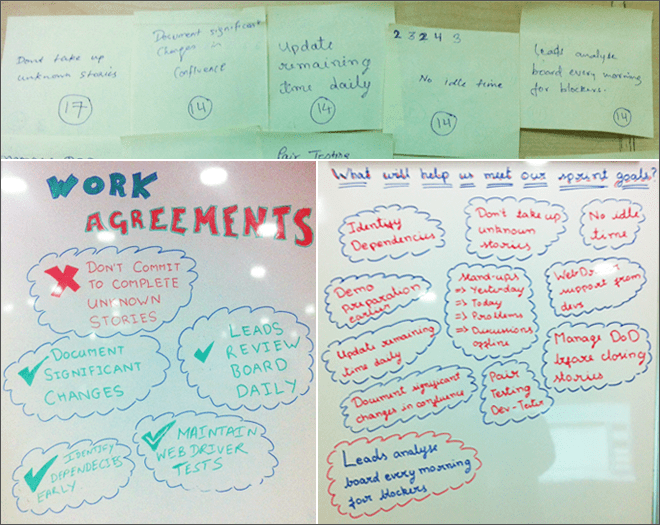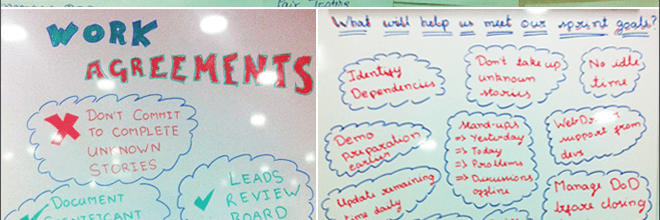Work Agreements for a Scrum Team
By Team Arrk |
|
3 mins read |

Work agreements are the set of rules/disciplines/processes the team agrees to follow without fail to make themselves more efficient and become self managing aspect of scrum. These agreements help the team build a shared understanding of what it means to work as a team.
Who sets the work agreements?
Team members themselves set the work agreements. The ScrumMaster may have to play the role of facilitating the meeting that’s held to come up with work agreements, but it is the team that decides on the agreements. The team also reviews them periodically during retrospective meetings.
What is the best time to organize this meeting?
We did this in our retrospective meetings. It can also be separate meeting by itself.
What do you need for this meeting?
- All team members.
- Whiteboard
- Marker
How do we come up with our first set of work agreements?
The ScrumMaster kicks off the meeting by explaining to the team what a work agreement is (as mentioned above) and then shares some examples of work agreements to give them a fair idea. For example: “I will update the status on the Scrum board regularly.” “Be on time for the stand-up.” And so on — It could be any thing that the team thinks are crucial for their success or improvement. The ScrumMaster then suggests to the team that they brainstorm the points that are crucial for their improvement and asks them to share the points they think should become work agreements.
Team members share their suggestions and the reasons why they think it should be part of the work agreements. Some of the points could be relatively straightforward. The ScrumMaster takes note of these ideas on the board.
After the brainstorming session, the ScrumMaster informs the team that they should pick the top five ideas as work agreements, based on voting. It’s a good idea to give each team member three or five votes and ask them to vote for the agreements on the board that they think are crucial.
After the voting, the ScrumMaster counts the votes and shares the top five agreements with team. The team should be reminded that these are the agreements, that they have consented to follow in order to be a successful team, and they should always adhere to it. If any team member does not adhere to any of the agreements, other team members should remind them about it.
These five agreements should be put up on display in the team’s shared space.
Maintaining the work agreements
Work agreements should be reviewed at the end of every sprint during the retrospective meeting. Once team members feel they are doing well on any agreement and there is something else which needs to be addressed/discussed and added as work agreement, they can replace it with another agreement after consensus.
My experience
There are a couple of work agreements, specific to our team, that have worked really well: “Don’t commit to unknown stories” and “Review the JIRA board daily and set a focus for each day.” Since we are a distributed team, we have a stand-up in the afternoon, when the onshore team from the U.K. is in their office. The team came up with this agreement to review the board in the morning and communicate what they will be working on. This has worked wonders; a lot of communication happens in this meeting, and I can see teamwork in the managing the sprint scope.
Other work agreements are: “Documentation for critical tasks” (the team plans it as subtask during planning wherever applicable) and “Identify dependencies” (to identify dependencies in an early stage and document them on tickets, either during look-ahead meetings or planning meetings).
Article published on Scrum Alliance website:
Work Agreements for a Scrum Team
Article selected for Scrum Alliance Feb 2014 news letter:
ScrumAlliance News








